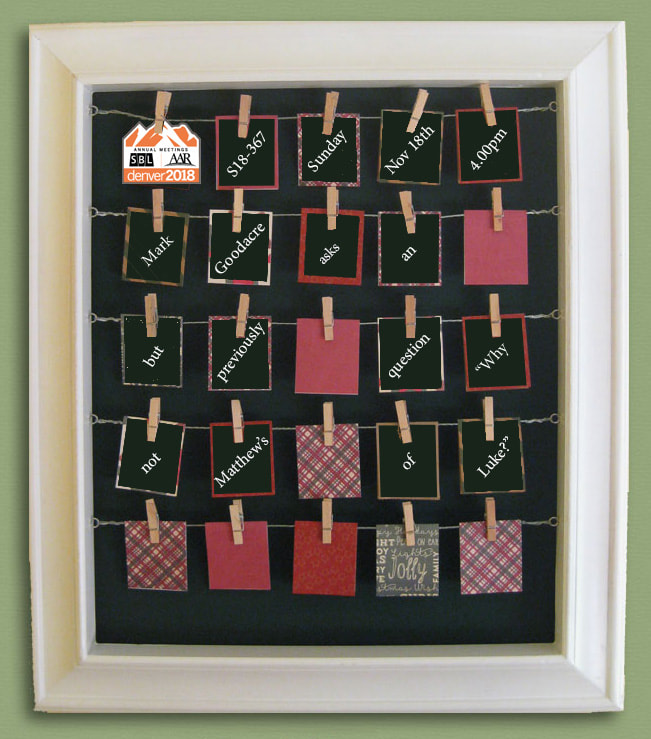| Alan Garrow Didache |
the problem page
|
Gerald Downing sets his readers challenge on pp. 330-1. He invites us to find some particular extended strings of letters that are closely mimicked in both texts, 'so as to know what Mt3rd is going to avoid'. He uses continuous majuscule text to more closely mimic the mass of letters that would have confronted Matthew if he were working from manuscripts of Mark and Luke. Even then, however, the true difficulty of the task is only hinted at because, of course, it is highly unlikely that the texts in Matthew's possession would have been so neatly and regularly scribed, and Matthew would not have been able to set them beside one another so closely. If you would like to try playing this game yourself, Downing invites you to look for: ΕΛΑΙΩΝΑΠΕΣΤΕΙΛΕΝΔΥΟΤΩΝΜΑΘΗΤΩΝΛΕΓΩΝΥΠΑΓΕΤΕΕΙΣΤΗΝΚΑΤΕΝΑΝΤΙΚΩΜΗΝΕΝΗΙΕΙΣΠΟΡΕΥΟΜΕΝΟΙ ΕΥΡΗΣΕΤΕΠΩΛΟΝΔΕΔΕΜΕΝΟΝΕΦΟΝΟΥΔΕΙΣΟΥΠΩΑΝΘΡΩΠΩΝΕΚΑΘΙΣΕΝ ΟΚΥΡΙΟΣΑΥΤΟΥΧΡΕΙΑΝΕΧΕΙ ΚΑΙΕΙΣΕΛΘΩΝΕΙΣΤΟΙΕΡΟΝΗΡΞΑΤΟΕΚΒΑΛΛΕΙΝΤΟΥΣΠΩΛΟΥΝΤΑΣ (the last of these is highlighted for you)
Downing's point is that it is truly remarkable that Matthew succeeds in 'assiduously avoiding' (p. 336) almost every one of the strings of 30+ letters shared virtually identically by Mark and Luke. [NB, by 'avoid' Downing means 'fail to copy verbatim' rather than 'omit altogether' cf. yesterday's post]. He suggests that 'had Mt3rd actually wanted to miss dual UCVSTs, then with both the texts before him, he could have physically done it, painstakingly. I must allow that it would have been physically possible, even if still quite difficult, time consuming. But why?' (p. 335). This is a fair point. It would have taken extraordinary labour to pick out these strings of agreement so as specifically to 'avoid' them. The only problem is that, just three paragraphs earlier, Downing states that: 'With that keen attention, mainly to Mark, but constantly aware of Luke, [Mt3rd] could hardly have failed to notice this common matter. Indeed, as argued, we would expect him to look for it, and value it. But he does not' (p. 334). Downing can't have it both ways. This common material is difficult to spot whether one wishes to include it or exclude it. Indeed, I struggle to imagine how such inclusion or exclusion could have been achieved without the use of a highlighter pen – or its ancient equivalent. What I mean is that, before actually starting work on his Gospel, Matthew would be required to work his way through Mark and Luke in parallel ‘highlighting’ all those passages where 30+ letters agree exactly. Without preparatory work of this kind how could Matthew have been alert (when working from one text or the other) to the presence a double-attested string of letters, so as to be sure to include it (or exclude it)? Furthermore, if Matthew did find some means remaining alert to this phenomenon, is it realistic to imagine that he would have surrendered all editorial autonomy at these points – no matter the consequences for the theology, economy, or coherence of his own creation? Downing concludes that for Matthew, 'regularly to exclude extensive common witness while using the other two is totally implausible, quite impossible to imagine coherently' (p. 336). However, if by 'exclude' we actually mean ‘express editorial freedom in relation to’, the imagination is barely taxed at all. All that is required is to imagine that Matthew saw himself as having the freedom to edit his sources as he saw fit, especially where elements of those sources were non-critical. And, as the coherence of the text of Matthew’s Gospel demonstrates, the exact preservation of these particular (very difficult to identify) word-strings is indeed non-critical. As an alternative to Downing’s model I suggest that Matthew was a conflator who sought to supplement what he found in Mark with the additional material he found in Luke (and elsewhere) – while also serving his own theological agenda (cf. Huggins, 1992). If this supposition is not too far-fetched, we would expect Matthew to follow Mark (editing along the way) while also sometimes switching to Luke (also editing as necessary). Under this arrangement, (and contrary to Downing’s firm expectation), the elements of Luke that would have been of least interest to Matthew would have been those where Luke was exactly similar to Mark. Conversely, the elements of Luke that would have been most interesting to Matthew would have been those places where Luke included further, valuable, supplementary material. Given that this imaginative scenario explains the data while also placing Matthew third, it really is not true to claim that Mt3rd is: ‘totally implausible, quite impossible to imagine coherently' (p. 336). Tomorrow I conclude this set of responses by noting the larger implication revealed by Downing's argument.
0 Comments
Your comment will be posted after it is approved.
Leave a Reply. |
AuthorAlan Garrow is Vicar of St Peter's Harrogate and a member of SCIBS at the University of Sheffield. Archives
April 2024
Categories |

 RSS Feed
RSS Feed